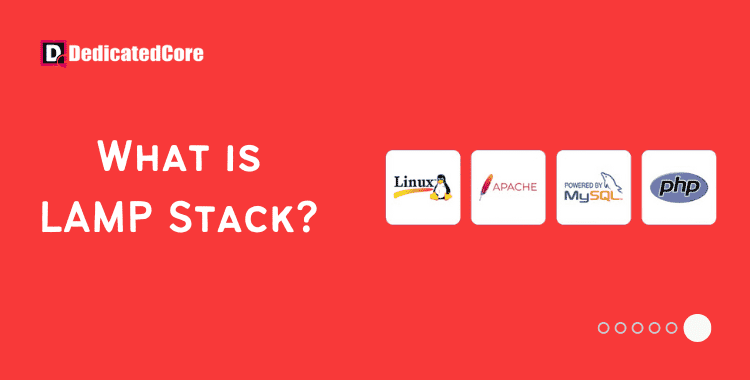The LAMP stack was born as a potent and adaptable option for creating dynamic websites. Also apps in the ever-evolving world of web development. The LAMP stack consists of the four pillars of Linux, Apache, MySQL, and PHP providing an open-source environment. LAMP stack enables developers to build dependable, scalable, and feature-rich web solutions.
LAMP stack has several advantages, which we will study in this blog step-by-step and understand what lamp stack is. Instructions for setting up your LAMP-based development environment. Now we will study the Lamp Stack in detail:
Learning about the LAMP Stack
The LAMP stack is an acronym for four key technologies. They combine to provide a complete web development environment. Choose our VDS hosting to handle intense visitor load of your website with 99.99% uplink. Understand what a LAMP is and what it defines:
Linux is the OS layer. It is a reliable base for hosting web apps. For server contexts, it is the best option. Its security, scalability, and open-source nature make it so.
Apache, the web server software, can send web content to browsers more easily. It provides several features, including managing virtual hosts. It has also provided HTTP requests and SSL/TLS secure communications.
MySQL is a relational database management system (RDBMS). Web applications may efficiently store and retrieve data. It is appropriate for applications of all sizes since it has different features. Features like data integrity, ACID compliance, and support for complicated queries.
PHP: As the preferred scripting language, PHP enables programmers to create dynamic websites. By integrating code into HTML. To handle user requests, access databases, and provide dynamic content, it communicates with the web server.
To understand in detail How to Install Lamp on Ubuntu watch the following video:
Constructing the LAMP Stack
Step 1: Install Linux in the First Step
Pick a distribution of Linux that fits your preferences. Ubuntu, CentOS, and Debian are popular options. The operating system can be installed on your server or local workstation. Installed following the installation instructions unique to your distribution.
Step 2: Install Apache in this Step
Installing Apache is the next step after installing Linux. Install Apache by using the Linux distribution’s package manager. Start the Apache service once it has been installed, then set it to launch automatically when the system boots.
Step 3: Install MySQL in this Step
Install MySQL to handle the database management for your application once Apache is up and running. Create databases and users as needed, secure MySQL settings, and a root password. The official documentation for MySQL includes comprehensive installation and configuration instructions.
Step 4: Install PHP Here
PHP is the last piece of the puzzle. Install PHP and the required modules to enable PHP and Apache communication. Set up PHP parameters, such as file upload restrictions and memory allocation, to correspond to the needs of your project.
Step 5: Test the setup in 5th Step
To check the connection of the LAMP stack, create a sample PHP file and place it in your Apache document root directory. Create a straightforward PHP script that establishes a connection to the MySQL database, retrieves data, and displays it on a website. Use a web browser to access this page to check the functionality of the complete stack.
Why Use the LAMP Stack?
Web-based applications are created and delivered using the LAMP stack. Smaller developers can compete with professional software development solutions thanks to their flexibility and efficiency.
The four components of the LAMP architecture were determined to be the most effective strategies for developers who want to host, manage, and serve web-based content. They offer a way to access information, programs, and other web-based resources.
To understand in detail How To Install LAMP on Alma Linux watch the following video:
Final Thoughts on What is LAMP Stack
The LAMP stack has remained popular throughout time. Because it enables programmers to build dynamic, stable, and feature-rich online applications. Linux, Apache, MySQL, and PHP make a great combo. It gives developers a scalable, versatile, and cheap environment. To avoid WordPress compatibility issues, upgrade PHP to the latest version on Ubuntu.
You can start your journey of developing web apps leveraging the power of the LAMP stack. By following the step-by-step setup guide offered in this blog. The LAMP stack is a key part of modern web development. This is true for all experience levels.
Frequently Asked Questions (FAQ)
1. What benefits does the LAMP stack offer when used with DomainRacer hosting?
Using the LAMP stack with DomainRacer hosting provides:
- Flexibility: Customize and scale your applications with ease.
- Compatibility: The stack works with many CMS platforms, such as WordPress and Joomla.
- Cost-Effectiveness: Every component is open-source, trimming software costs to the essentials. DomainRacer fine-tunes its hosting plans, particularly for LAMP stack applications. Expect stellar performance and rock-solid security with every click.
2. Can I host many websites using the LAMP stack?
Yes, the LAMP stack can host many websites on the same server using Apache’s virtual hosts. Each website can have its own directory, configuration file, and domain name. For example, create separate config files in /etc/apache2/sites-available/ for each website. Then, enable them with:
sudo a2ensite your-site.conf sudo systemctl reload apache2
DomainRacer’s hosting plans let you host many websites. They have strong LAMP stack support.

